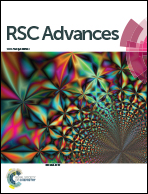Interaction of chitosan beads with a copper–naproxen metallodrug
Abstract
This manuscript reports a novel hybrid system containing a copper-drug entrapped into the chitosan biopolymer. Chitosan beads (CTb) were prepared and investigated for interaction with a copper metallodrug (CuNpx) of the naproxen (HNpx) non-steroidal anti-inflammatory drug. The loading capacity of CTb for CuNpx suggests a sponge-like behavior for copper-drug entrapping at a CuNpx concentration range from 10−4 to 10−2 mol L−1. A novel CTb/CuNpx hybrid material formed by the copper-drug loaded into chitosan beads was prepared and characterized by elemental analysis, scanning electron microscopy, electronic absorption spectroscopy, FTIR spectroscopy, X-ray diffractometry and thermal analysis. The CTb/CuNpx hybrid material was coated with Acrycoat S100, and its behavior in gastric/intestinal pH simulated solutions was investigated to verify potential releasing properties. The coated beads showed a capacity to release naproxen in a sustained release manner for at least 24 h.


 Please wait while we load your content...
Please wait while we load your content...